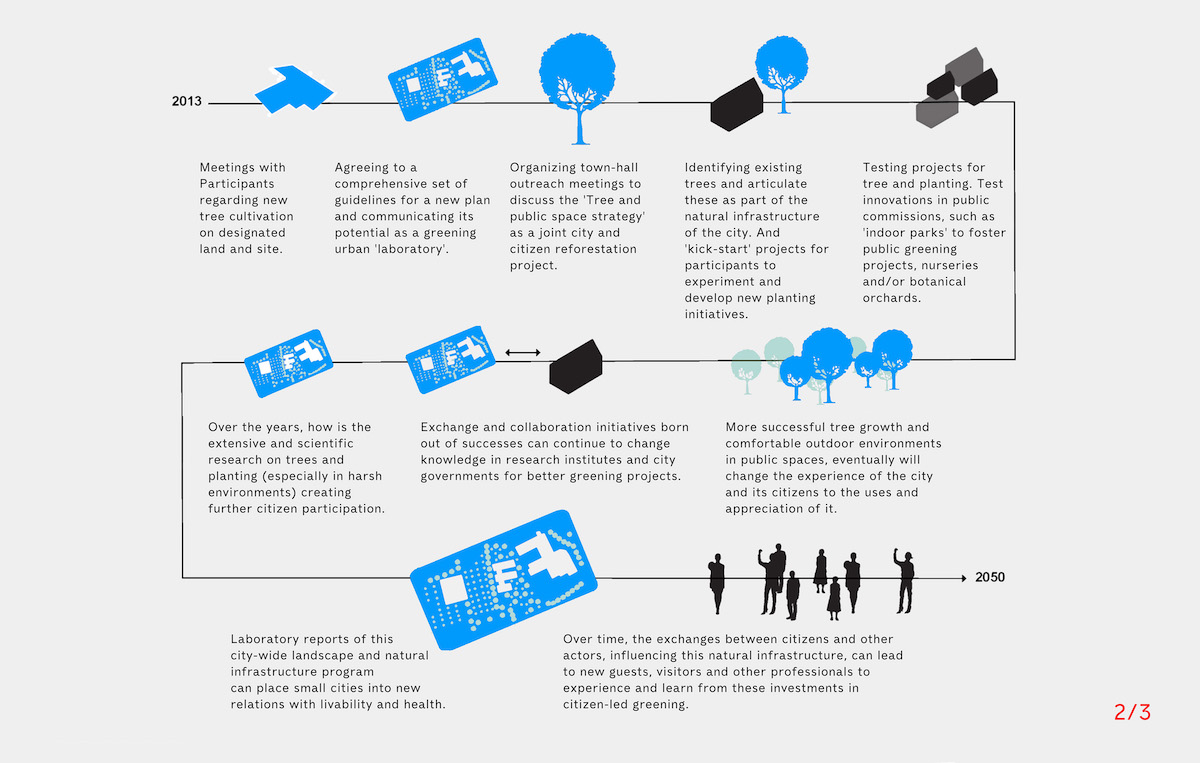I became aware of LA artist Hugo Hopping in 2009, when his conceptual work appeared in the exhibition “Post American L.A.,” curated by Pilar Tompkins Rivas for the 18th Street Arts Center in Santa Monica. Since then his trajectory has taken him to base his practice between Los Angeles and Copenhagen, where he co-founded The Winter Office (TWO) with Johanna Ferrer Guldager. TWO is an experimental and professional group of artists, curators, architects, designers and social scientists, who are exploring artistic and design interventions looking to uncover emerging solutions for a sustainable urban and natural infrastructure.
TWO’s theoretical and creative approach to architecture, urban planning and art is deeply enmeshed in the climate challenges of a warming world. Through a process of collaborative experimentation, TWO explores problem-solving through idea-sharing and research workshops, including rising housing inequality, economic displacement, houselessness and environmental disaster. Hopping, with members of TWO, were back at 18th Street in 2019 for a residency. They developed a study of the cultural landscape of the surrounding urbanity and communities, including climate gentrification. TWO also presented at the Armory Center in Pasadena, with “Non-Perfect Dwelling,” a visual environment where urgent approaches to dwelling and cohabitation could be imagined and planned.

Rewildering Holographic Weeds, TWO, 2020
Cover for the new publication, Nature As Infrastructure
After quarantine in Copenhagen, Hugo Hopping is back in LA, doing advance work for TWO’s project, Nature As Infrastructure. Last year it was road-tested at the European Biennial Manifesta 13 in Marseilles, France. Their project is researching how to re-establish new connections to nature, rethinking a renewal of society, and inspiring the design of future public spaces by asking how to reintroduce nature into cities. Following a methodology they describe as the “creative practice of spatial justice,” TWO navigates from discourses of power and human survival to conversations of collaboration and thriving.
TWO’s and Hopping’s practical-theoretical research is being conducted in Frogtown’s Elysian Valley and will be a continuation of the forthcoming Nature As Infrastructure publication. It documents and describes their work on designing forests as a program element leading to the establishment of natural infrastructure. Hopping says, “Frogtown is a very special area walled by the 5 Freeway and the LA River, near urban parks and a sizable number of trees. However little or no sound walls or the use of trees to absorb the plastic and CO2 pollution is in place. The lines in the diagrams for the project suggest the interplay between full-grown tree canopies and shared cultivation models mixing public and private land to build a powerful natural infrastructure. Our study aims to understand this area in full in order to generate a near-future proposal that can involve public and private participation to help implement most of our suggestions.”

This second diagram image relates directly to what TWO plans to further theorize for Elysian Valley and that they hope citizens can buy into in practice and for full implementation.
Perhaps a precursor to TWO’s work is articulated in Suzi Gablik’s thesis, The Re-Enchantment of Art (1991). It promoted reconstructive art practices with a basis in real-world solutions. TWO’s work also brings to mind recent LA participatory environmental projects that were artist-centric. Mel Chin’s The TIE that BINDS: MIRROR of the FUTURE, a water conservation art project, was part of Los Angeles’ 2016 Public Art Biennial. Chin’s project began at the Bowtie, a parched stretch of land adjacent to the LA River in Atwater Village, where eight sample gardens were created. The project envisioned drought-resistant gardens planted throughout LA, reflecting a climate-appropriate collective-future landscape. Another inspirational project was by artist Lauren Bon. Her Not A Cornfield was a 2005 art project that transformed a 32-acre industrial brownfield into a cornfield for one agricultural cycle. It was a wonderful breath of optimism and boosted public awareness that this area could be more than another industrial site, expediting the process of turning the site into a State Historic Park.
Nature As Infrastructure, along with the launch of TWO’s publication about the project, discusses the importance of generating higher standards of spatial justice through the design of urban forests, along with new roles of citizen participation. LA as a laboratory for environmentally based social practice art is unique because the city embodies many of the climate change and climate justice extremes and challenges we face. Artists and thinkers like Hopping and TWO, who address these issues proactively, are on the leading edge of an evolving, collective 21st-century art and social science practice.
An advance look at TWO’s forthcoming publication can be seen at https://rssprss.net/product/nature-as-infrastructure-two/

